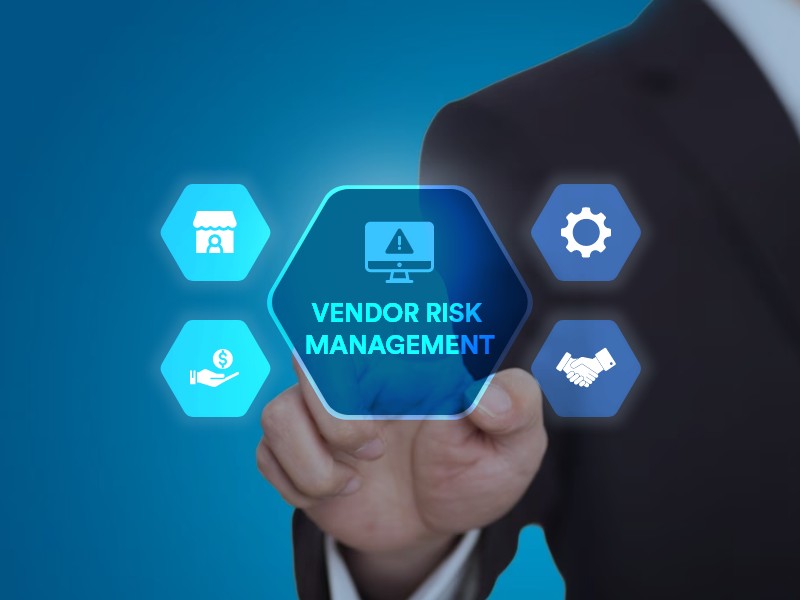Vendor Risk Management in Facility Vendor Partnerships: Vendor Risk Assessment and Mitigation Strategies

Facility-vendor partnerships have become critical for ensuring efficient operations and sustainable growth. Collaborating with trusted vendors offers many benefits that extend far beyond cost reduction. Facility vendor partnerships also foster innovation and allow businesses to swiftly adapt to changing market dynamics. Furthermore, they facilitate the allocation of resources towards core competencies while entrusting non-core functions to experts. Thus, nurturing strong vendor relationships has become an imperative for businesses striving to thrive in today’s global marketplace.
Risk mitigation is indispensable in safeguarding an organization’s continuity and ensuring adherence to regulatory frameworks. In an era of evolving threats and complex regulations, enterprises must proactively identify, assess, and manage risks. Effective risk management shields businesses from potential disruptions and upholds their commitment to compliance, ethics, and corporate responsibility.
By systematically evaluating vulnerabilities and implementing robust risk mitigation strategies, companies can fortify their resilience against unforeseen crises. Moreover, stringent compliance measures are vital to maintaining public trust and avoiding legal repercussions. In this context, risk mitigation acts as the linchpin between business continuity and compliance, providing the necessary framework to navigate today’s challenging business landscape while preserving the integrity and sustainability of the organization.
Understanding Vendor Risk in Facility Vendor Partnerships
Comprehending the risk landscape in facility vendor partnerships is crucial for successful collaborations. This involves identifying potential risks and assessing their potential impact and likelihood. Here’s an elaboration of these critical components:
Identifying potential risks in facility vendor partnerships involves:
Operational risks: Operational risks in facility vendor partnerships encompass various challenges that may disrupt day-to-day operations. These risks could include vendor performance issues, supply chain disruptions, quality control problems, and technology failures. Operational risks can arise from misalignment in processes, inadequate communication, or reliance on single-source vendors.
Compliance risks:
Compliance risks pertain to the potential violation of regulatory requirements, contractual obligations, or industry standards. These risks may emerge from vendor non-compliance, failure to meet quality standards, data security breaches, or unethical practices. Compliance risks can result in legal consequences, reputational damage, and financial penalties.
Financial risks:
Financial risks involve monetary losses or disruptions to financial stability due to vendor-related issues. These risks may arise from cost overruns, unexpected expenses, currency fluctuations, or vendor insolvency. Economic troubles can impact profitability, cash flow, and the organization’s financial health.
Evaluating the impact and likelihood of identified risks is critical in risk management. This process involves:
Impact Assessment:
This entails evaluating the potential consequences of each risk on the organization. For example, the impact of an operational risk could range from minor disruptions to a complete halt in operations. In contrast, a compliance risk might result in fines, legal action, or damage to reputation. Assessing impact allows organizations to prioritize risks based on their potential severity.
Likelihood Assessment:
Likelihood assessment involves determining the probability of each risk occurring. This evaluation considers historical data, industry trends, vendor performance history, and other relevant factors. Assessing likelihood helps organizations focus on addressing risks more likely to materialize.
By systematically identifying and assessing these risks, organizations can develop risk mitigation strategies tailored to each type of risk. This proactive approach allows for better decision-making in selecting and managing facility vendor partnerships, ensuring business continuity, compliance, and overall operational resilience.
Establishing Effective Vendor Risk Management Strategies
Establishing robust risk mitigation strategies is crucial for facility vendor partnerships to safeguard your organization’s interests and ensure smooth operations. It involves a proactive approach with thorough risk identification, assessment, mitigation planning, and knowing how to measure KPI for vendors. Due diligence in vendor selection, well-negotiated contracts, and ongoing performance monitoring are essential components of a comprehensive risk management plan. This ensures that your partnerships contribute positively to your organization’s goals while minimizing potential disruptions and liabilities. Here, we’ll delve into the critical components of such systems.
Developing a risk management plan for facility vendor partnerships involves:
Risk Identification:
The primary step of crafting an effective risk management plan is identifying potential risks within your vendor partnerships. This process should involve a comprehensive analysis of operational, compliance, and financial risk. Engaging relevant stakeholders to understand the risks specific to your organization is crucial thoroughly.
Risk Assessment:
After identifying risks, assess their potential impact and likelihood, as discussed in the previous section. Assign a risk rating to each identified risk to prioritize them based on severity and probability.
Risk Mitigation Strategies:
Once risks are identified and assessed, develop specific mitigation strategies for each risk category. These strategies may include contingency plans, preventive measures, risk transfer through insurance, or risk acceptance if the potential impact is deemed acceptable.
Evaluating Vendor Reputation and Financial Stability:
Before entering a partnership, thoroughly assess potential vendors’ reputations and financial stability. This involves scrutinizing their track record, industry standing, client references, and financial health. A financially stable vendor is less likely to experience economic disruptions that could affect your operations.
Assessing Vendor’s Compliance History:
Compliance is another crucial aspect of risk management. Research the vendor’s compliance history, including past legal or regulatory issues. A vendor with a history of non-compliance may pose a higher compliance risk to your organization.
Clearly Defining Responsibilities and Expectations:
Contracts and service level agreements (SLAs) should clearly mention the roles and responsibilities of both the client and service provider. This includes deliverables, performance metrics, quality standards, timelines, and dispute resolution mechanisms. Clear expectations reduce the likelihood of operational disputes and facilitate smoother collaboration.
Incorporating Contingency Plans and Disaster Recovery Measures:
Contingency plans and disaster recovery measures should be integrated into contracts and SLAs. These plans should outline how both parties will respond to various scenarios, such as supply chain disruptions, natural disasters, or cybersecurity incidents. Having predefined strategies in place enhances your ability to navigate unforeseen challenges.
Ongoing Performance Monitoring:
Implement a robust system for continuously monitoring vendor performance. This includes regular assessments of key performance indicators (KPIs) outlined in the SLA. Promptly address deviations or issues to ensure the vendor meets its obligations.
Periodic Audits:
Conduct periodic audits to ensure compliance with contractual and regulatory requirements. These audits can identify potential risks or areas for improvement. They also serve as a means to reinforce the importance of compliance and quality standards.
Risk Assessment to Ensure Business Continuity with Your Facility Vendor Partners
Ensuring business continuity is not a one-time effort but an ongoing commitment. Collaborating with vendors to develop and update business continuity plans, testing these plans rigorously, and implementing backup solutions for critical operations are integral steps in this process.
By working in tandem with vendors and staying agile in addressing evolving risks, organizations can safeguard their ability to operate seamlessly, even in the face of unexpected challenges, thereby minimizing downtime and preserving customer trust. This section focuses on strategies and practices to guarantee that your organization remains operational, even in the face of unexpected disruptions.
Shared Responsibility:
Business continuity planning is not solely the organization’s responsibility. Collaborating with vendors to develop these plans is crucial because vendors often play a significant role in key business processes. This collaboration ensures alignment and coordination in case of disruptions.
Identifying Critical Functions:
The first step is to identify critical functions and dependencies on vendor services. Both parties should assess how their operations interconnect and which processes are vital for business continuity.
Joint Planning:
Develop business continuity plans in collaboration with vendors. These plans should outline responsibilities, communication protocols, and recovery strategies. This collaborative approach ensures that both your organization and your vendors are on the same page when mitigating disruptions.
Regularly testing and updating these plans to address evolving risks:
Testing and Simulation: Business continuity plans should not gather dust on shelves; they need to be actively tested and refined. Regularly conduct tabletop exercises and simulations to ensure everyone understands their roles during a crisis. These exercises also reveal weaknesses that can be addressed before a real disruption occurs.
Evolving Risks:
The business landscape is constantly evolving, and so are the risks. Continuous risk assessments should be part of the process. Consider factors like technological advancements, geopolitical changes, and emerging threats. Update your plans accordingly to stay resilient.
Critical Operations Identification:
Identify the core operations that must be maintained during disruptions. These functions directly impact revenue generation, customer satisfaction, and regulatory compliance.
Backup Solutions:
Implement robust backup solutions for critical operations. This could involve redundant systems, data backups, cloud-based services, or geographically dispersed facilities. The goal is to have failover mechanisms in place so that if one part of the operation is disrupted, there is an alternative path to continue operations.
Testing Backup Systems:
Regularly test the backup systems to ensure they function as intended. This testing includes data recovery drills, failover testing, and assessing the efficiency of contingency plans. Verifying that backup solutions are ready to kick in when needed is essential.
Vendor Risk Assessment to Ensure Compliance
Compliance is fundamental to business operations, and navigating the complex web of regulatory requirements and industry standards is imperative. It is a multifaceted process that demands vigilance, collaboration, and proactive engagement.
Understanding regulatory requirements and industry standards, ensuring vendor compliance through due diligence and contractual agreements, and fostering a collaborative compliance culture with vendors are essential components of a comprehensive compliance strategy.
By working together to meet these requirements, organizations and their vendors can avoid legal and reputational risks and foster a culture of trust and responsibility within their partnerships. This section outlines key strategies for ensuring compliance within your affordable facility management software or vendor partnerships.
In-Depth Knowledge:
To ensure compliance, organizations must have an in-depth understanding of the specific regulatory requirements and industry standards that pertain to their operations. This involves thorough research, staying updated on regulatory changes, and engaging legal and compliance experts as needed.
Customized Approach:
Regulations and standards can vary significantly across industries and regions. Therefore, tailoring compliance efforts to your organization’s specific context is crucial. This customization ensures your compliance strategy aligns with your industry’s unique challenges and obligations.
Risk Assessment:
Conduct an extensive risk assessment to identify potential compliance gaps. This involves evaluating how various regulations and standards impact your operations and determining areas where non-compliance poses the greatest risk.
Vendor Due Diligence:
Prior to entering into partnerships, thoroughly vet vendors to ensure they are compliant with all relevant laws and regulations. This due diligence process should encompass a review of their regulatory history, certifications, licenses, and any past legal issues.
Contractual Obligations:
Embed compliance requirements into vendor contracts and Service-Level Agreements (SLA). Clearly outline the specific regulatory and industry standards vendors must adhere to throughout the partnership. Include clauses that stipulate consequences for non-compliance.
Continuous Monitoring:
Implement a system for ongoing monitoring of vendor compliance. This may involve regular audits, inspections, and the sharing of compliance reports. Stay vigilant for any changes in regulations that may affect vendor compliance and address these proactively.
Communication and Education:
Establish open channels of communication with vendors to facilitate collaboration on compliance matters. Educate vendors about your organization’s compliance expectations and encourage them to share their compliance processes and initiatives.
Shared Responsibility:
Both your organization and your vendors are equally responsible for maintaining compliance. Collaborate to identify areas where joint efforts can enhance compliance. This could involve sharing best practices, conducting joint training sessions, or engaging in mutual audits.
Regular Reviews:
Conduct periodic reviews with vendors to assess their compliance performance. These reviews should provide a platform to discuss compliance challenges, share updates on regulatory changes, and jointly plan for continuous improvement.
Conclusion:
In today’s complex business landscape, facility-vendor partnerships ensure seamless operations. From managing facilities maintenance to overseeing security measures, these partnerships are instrumental in keeping businesses running smoothly. However, with the ever-present threat of unforeseen risks, it becomes imperative to prioritize not just risk mitigation but also maintenance vendor optimization—ensuring that vendors are not only reliable but also aligned with performance, cost, and compliance goals.
To achieve long-term success in facility partnerships, it is essential to encourage organizations to prioritize risk mitigation. This involves fostering a proactive risk identification, assessment, and management approach. Integrating business ethics into this framework reinforces accountability and responsible decision-making, helping teams evaluate risks not only from operational but also from ethical standpoints. Implementing preventive measures, creating contingency plans, and regularly monitoring potential risks are crucial steps toward minimizing vulnerabilities and ensuring uninterrupted operations.
By recognizing the importance of risk mitigation in facility vendor partnerships and making it a central focus, businesses can forge stronger collaborations that withstand the test of time and empower them to thrive in an increasingly uncertain world. FieldCircle can help you streamline your facility management practices. So connect with our experienced team soon!


